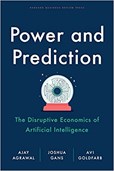- Innovation
The Disruptive Economics of AI
Rotman economists, Ajay Agrawal, Joshua Gans and Avi Goldfarb, delve deep into the transformative power of artificial intelligence
This insight clarified the economic effect of AI in a business context and provided a basis for executives and entrepreneurs to focus strategic action. In an era of extreme uncertainty this was and is important. Uncertainty hampers decision-making and holds back strategy. A better, faster, access to reliable predictions can unblock this, easing decision-making, and creating opportunities for business growth.

In their new book, Power and Prediction, Ajay Agrawal, Joshua Gans, and Avi Goldfarb, eminent economists from Rotman School of Management, address gaps in their original thinking. And offer new insights that have been revealed as more and more organizations have adopted AI technologies across different industries. In considering the economics of AI, rather than focusing as they had on the manifest capabilities of AI technology itself, the authors realized they should pay more attention to context—the varied systems in which AI operates or might potentially operate and the economic forces on them.
While it remains true that AI creates value through improved decision-making, it has become clear that effective AI adoption and real transformation is dependent on the creation of new systems driven by the technology. This became apparent because many nimble small companies, as well as larger companies already well staffed with data scientists, quickly adopted AI solutions, whereas other organizations that could benefit from AI were very slow to adopt. The sluggishness being largely due to these organizations being constrained by their existing rules and systems, which made them resistant to the changes successful AI adoption typically entails.
For example, in the case of innovation productivity, where AI can help move from reliance on trial and error to fast and credible hypothesis generation, progress is only made if the next steps in the process are redesigned to allow for this new-found efficiency—otherwise it will just lead to a bottleneck of untested, undeveloped ideas, rather than clear decision taking. The entire innovation system needs to be redesigned.
Decision-making, the authors remind us, involves prediction and judgment—an instinctive two-part mental process we don’t always differentiate. Machine learning and AI technologies shift the prediction part from humans to machines, increasing the speed and accuracy of predictions. For the judgement part to keep pace organizations need to create or redesign their systems. Redesigning systems of interdependent decisions takes time, and for many industries the authors say we are at a "between time"—but “when these new systems emerge, they can be disruptive on a global scale.”
Power and Prediction offers an invaluable guide to these complex developments—helping companies navigate what is likely to be a profound change, that for most will be unavoidable if they want to stay competitive. While highlighting the opportunities and economic benefits, the book also addresses some of the threats and barriers to AI fulfilling its potential in organizations. The authors introduce several concepts that need to be considered, such as:
The Between Times. The current uncertain start to AI adoption, due to a lack of appreciation of the effect of the larger systems in which AI operates, will pass and adoption will accelerate. Some will be left behind.
The AI Bullwhip. Small changes in one area, brought by AI driven decisions, may reverberate through a system and lead to unintended consequences and possible cracks elsewhere.
Power and Disruption. AI only has power as it leads to better decisions. Humans still control decision-making and it is wrong to think that AI per se holds any power. Value creation depends on organizations changing so that humans and machines can work together well.
Bias and Discrimination. It is often suggested that AI can perpetuate bias. The authors argue that AI can detect bias and adjust for it. However, this requires overcoming challenges around regulations designed for the pre-AI era and resisting external pressure for bias.
…………………………………………………………………………………………………………………………
Rotman School of Management is Canada’s leading business school and has Canada’s largest group of management faculty. It is home to some of the most innovative research institutes in the world
ARTICLES YOU MIGHT LIKE
VIEWPOINT
Cognitive neuroscientist, Lynda Shaw, explains how to understand and support intrapreneurs
DEVELOPING LEADERS QUARTERLY MAGAZINE AND WEEKLY BRIEFING EMAILS


































